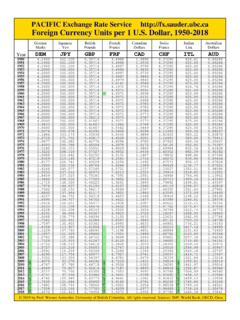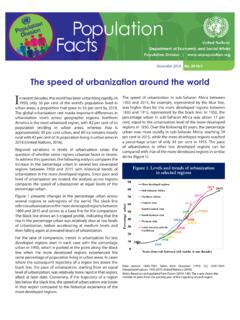Transcription of The Facts of Economic Growth - Stanford University
1 CHAPTER 1 The Facts of Economic JonesStanford GSB, Stanford , CA, United StatesNBER, Cambridge, MA, United at the Economic Over the Very Long of Frontier the Facts of Frontier Growth : Beyond Rise of Worked and Price of Natural Spread of Economic Long Spread of Growth in Recent Distribution of Income by Person, Not by TFP : A Theory of and the Role of and Economic vs Hsieh Klenow Diffusion of of Macroeconomics,Volume2A 2016 Elsevier 1574-0048, are people in the richest countries of the world so much richer today than 100 years ago? And whyare some countries so much richer than others? Questions such as these define the field of economicgrowth. This paper documents the Facts that underlie these questions. How much richer are we todaythan 100 years ago, and how large are the income gaps between countries?
2 The purpose of the paper isto provide an encyclopedia of the fundamental Facts of Economic Growth upon which our theories arebuilt, gathering them together in one place and updating them with the latest available Growth , Development, Long-run Growth , ProductivityJEL Classification CodesE01, O10, 04 [T]he errors which arise from the absence of Facts are far more numerous and more durable thanthose which result from unsound reasoning respecting true data. Charles Babbage, quoted in(Rosenberg, 1994, p. 27). [I]t isquitewrong to try founding a theory on observable magnitudes is the theorywhich decides what we can observe. Albert Einstein, quoted in (Heisenberg, 1971, p. 63).Why are people in the United States, Germany, and Japan so much richer today than 100or 1000 years ago? Why are people in France and the Netherlands today so much richerthan people in Haiti and Kenya?
3 Questions like these are at the heart of the study ofeconomic seeks to answer these questions by building quantitative models modelsthat can be compared with empirical data. That is, we d like our models to tell us notonly that one country will be richer than another, but by how much. Or to explainnot only that we should be richer today than a century ago, but that the Growth rateshould be 2% per year rather than 10%. Growth economics has only partially achievedthese goals, but a critical input into our analysis is knowing where the goalposts lie thatis, knowing the Facts of Economic purpose of this paper is to lay out as many of these Facts as (1961)was content with documenting a few key stylized Facts that basic Growth theory shouldhopeto Romer (2010)updated his list to reflect what we ve learnedover thelast50 years.
4 The approach here is different. Rather than highlighting a handfulof stylized Facts , we draw on the last 30 years of the renaissance of Growth economics tolay out what is known empirically about the subject. These Facts are updated with thelatest data and gathered together in a single place potentially useful to newcomersto the field as well as to experts. The result, I hope, is a fascinating tour of the growthliterature from the perspective of the basic of MacroeconomicsThe paper is divided broadly into two parts. First, I present the Facts related to thegrowth of the frontier over time: what are the Growth patterns exhibited by the richestcountries in the world? Second, I focus on the spread of Economic Growth throughoutthe world. To what extent are countries behind the frontier catching up, falling behind,or staying in place?
5 And what characteristics do countries in these various groups share?1. Growth AT THE FRONTIERWe begin by discussing Economic Growth at the frontier. By this I mean growthamong the richest set of countries in any given time period. For much of the last century,the United States has served as a stand in for the frontier, and we will follow this Modern Economic GrowthFig. 1shows one of the key stylized Facts of frontier Growth : For nearly 150 years, GDPper person inthe US economy has grown at a remarkably steady average rate of around2% per year. Starting at around$3,000 in 1870, per capita GDP rose to more than$50,000 by 2014, a nearly 17-fold the large, sustained Growth in living standards, several other features of thisgraph stand out. One is the significant decline in income associated with the Great18801900192019401960198020002000400 0800016,00032,00064, per yearYearLog scale, chained 2009 dollarsFig.
6 1 GDP per person in the United States. Source:Data for 1929 2014 are from the Bureauof Economic Analysis, NIPA table Data before 1929 are spliced from Maddison, A. 2008. Statisticson world population, GDP and per capita GDP, 1-2006 AD. Downloaded on December 4, 2008 Facts of Economic GrowthDepression. However, to me this decline stands out most for how anomalous it is. Manyof the other recessions barely make an impression on the eye: over long periods of time, Economic Growth swamps Economic fluctuations. Moreover, despite the singular sever-ity of the Great Depression GDP per person fell by nearly 20% in just 4 years it isequally remarkable that the Great Depression wastemporary. By 1939, the economy isalready passing its previous peak and the macroeconomic story a decade later is once againone of sustained, almost relentless, Economic stability of US Growth also merits some discussion.
7 With the aid of the trend lineinFig. 1, one can see that Growth was slightly slower pre-1929 than 1makesthispointmoreprecisely. Between 1870 and 1929, Growth averaged , vs 1929 and 2007 (using peak to peak dates to avoid business cycle problems).Alternatively, between 1900 and 1950, Growth averaged vs since one is too quick to conclude that Growth rates are increasing; however, noticethat the period since 1950 shows a more mixed pattern, with rapid Growth between1950 and 1973, slower Growth between 1973 and 1995, and then rapid Growth duringthe late 1990s that gives way to slower Growth more interesting trees that one sees inTable 1serves to support the main point onegetsfromlookingat the forest inFig. 1: steady, sustained exponential Growth for thelast 150 yearsis a key characteristic of the frontier.
8 All modern theories of economicgrowth for example,Solow (1956), Lucas (1988), Romer (1990), andAghion andHowitt (1992) aredesignedwith this fact in sustained growthinFig. 1also naturally raises the question of whether suchgrowth can andwill continue for the next century. On the one hand, this fact more thanany other helps justify the focus of many Growth models on the balanced Growth path,a situation in which all Economic variables grow at constant exponential rates the logic of the balanced Growth path suggests that the Growth can continue indef-initely. On the other hand, as we will see, there are reasons from other Facts and theoriesto question this 1 The stability of US GrowthPeriodGrowth Rate PeriodGrowth Rate1870 2007 1995 1929 2007 2007 1950 2001 2007 2007 1973 2007 :Annualized Growth rates for the data shown inFig.
9 Of Growth Over the Very Long RunWhile the future of frontier Growth is surely hard to know, the stability of frontier growthsuggested byFig. 1is most certainly misleading as a guide to Growth further back in 2shows that sustained exponential Growth in living standards is an incrediblyrecent and thousands of years, life was, in the evocativelanguage of Thomas Hobbes, nasty, brutish, and short. Only in the last two centurieshas this changed, but in this relatively brief time, the change has been the year 1 and the year 1820, living standards in the West (measuredwith data from Western Europe and the United States) essentially doubled, from around$600 per person to around$1200 per person, as shown inTable 2. Over the next200 years;however,GDP per person rose by more than a factor of twenty, reaching$26, era of modern Economic Growth is in fact even more special than this.
10 Evidencesuggests that living standards were comparatively stagnant for thousands and thousands ofyears before. For example, for much of prehistory, humans lived as simple hunters andgatherers, not far above subsistence. From this perspective say for the last 200,000 years02004006008001000 1200 1400 1600 1800 200051015202530354045 PopulationPer capita GDPYearIndex ( in initial year)Fig. 2 Economic Growth over the very long run. Source:Data are from Maddison, A. 2008. Statistics onworld population, GDP and per capita GDP, 1-2006 AD. Downloaded on December 4, 2008 the West, ie, WesternEurope plus the United States. A similar patternholds using the world numbers from that played a key role in documenting and elaborating upon this fact includeMaddison (1979),Kremer (1993), Maddison(1995), Diamond (1997), Pritchett (1997), andClark (2001).



















